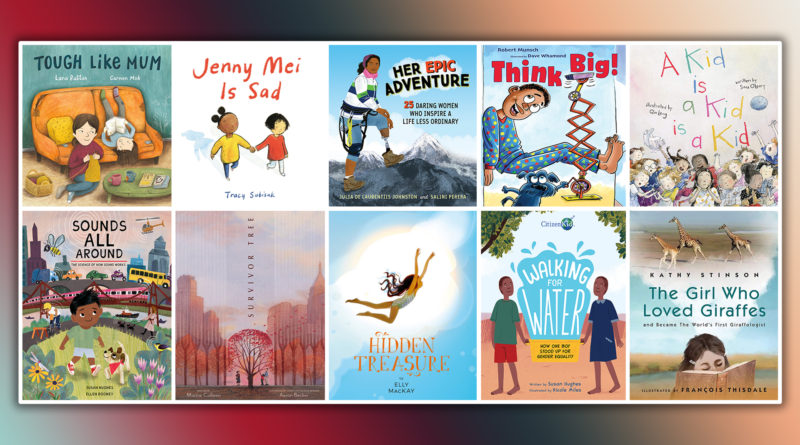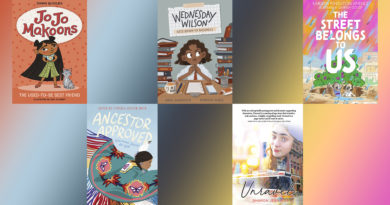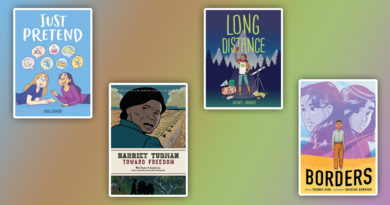Picture books you need to read as school begins

Tough Like Mum by Lana Bunton (Author) and Carmen Mok (Illustrator) – Tundra Books/Penguin Random House
Strength can show itself in many forms. Tough Like Mum is narrated by primary school-aged Kim and provides a child-centred perspective on poverty. “Everyone in town” sees that Kim is “tough” like her single mother, who works as a waitress: “Jen’s kid. Just as tough as her mum,” says her classmate’s father. It’s difficult for Kim’s mum to make ends meet. Their home is candlelit at night, suggesting that the power has been turned off: “I don’t need the stove to make this soup taste good,” Kim says. Food items seem to be in short supply. The only bread left for lunch are “just ends. So the last two pieces of pepperoni and a mustard smile.” Still the childis determined to sustain her optimism, channeling her mother throughout the school day, who neither left her money for a class field trip or checked off the “I can’t pay” box on the permission form. Mok’s simple, carefully shaded gouache and coloured-pencil art underlines this sensitive portrayal of the strong bond between a mother and her child navigating financial hardships. Tough Like Mom will tug at readers’ hearts while imparting the important message that welcoming help is a show of strength, not weakness.

Hidden Treasure by Elly McKay – Running Press Kids/Hachette Book Group
From award-winning author-illustrator Elly MacKay comes a charming story about exploring the treasures in everyday places. When a young treasure seeker goes to the beach for a day, she finds that treasure is all around her. On the way to the bay, they pass a souvenir shop: “They sell treasure here at the store. But it’s not the kind we’re looking for” because treasure is best when it is found. The beach is a trove of possible treasure awaiting discovery: beach stones in the sand and a whale’s tooth in the water. Some treasures have stories to tell, like a rusty key and a bubble wand. Others, like cocoons, are too precious to keep, and the treasure is in the joy of observation and anticipation of what will emerge. Nothing makes the young narrator feel more like a queen than a perfect day at the beach with her grandfather, Papa and their beloved dog.
The book features McKay’s diorama technique and warm pastel artwork. The illustrations combined with the lyrical, rhyming text evoke a wonder-filled, unhurried day at the beach. Hidden Treasure is a reflective ode to discovering treasures all around, of spending time with loved ones, valuing the wonders of nature.

Walking for Water: How One Boy Stood Up for Gender Equality by Susan Hughes (Author) and Nicole Miles (Illustrator) – Kids Can Press
When Victor and his twin sister Linesi turn eight years old, Linesi must stop going to school. Every morning, they walk to the kachere tree before parting ways. Victor goes on to school while Linesi heads to the riverbed to fetch water with a bucket, and carry out other household tasks for the family like the other women and older girls in their village. Because he is a boy, Victor is permitted to continue his education. He enjoys English lessons from his teacher, Mr Tambala. One day, his teacher talks about gender equality and asks the students to observe it in their own lives. Victor notices that the girls do the domestic chores while boys go to school and play games. Realizing the unfairness of this arrangement, he tries to teach Linesi what he has learned in classes each day. Unfortunately, Linesi is too exhausted from her tasks to learn at night, prompting Victor to devise a plan that will give both siblings an opportunity to gain an education: they will take turns going to school and fetching water. Soon, other families follow suit, which implies the start of a cultural shift.
Nicole Miles’ beautiful illustrations feature full scenes and vignettes to enrich the inspiring true story. Walking for Water will open readers’ eyes to the gender inequality in Malawi, and how one individual’s actions can catalyze a community’s progress towards parity. It is inspirational in its message of hope for a more equitable future and will catalyze a dialogue about gender inequality that persists today.

Jenny Mei Is Sad by Tracy Subisak – Little, Brown/Hachette Book Group
Jenny Mei Is Sad is narrated by Jenny Mei’s unnamed Black best friend. The plot centres on Jenny Mei’s pervasive sadness, which she tries to hide beneath jokes and smiles. Certain days are harder than others, and the narrator knows that despite her outward smile, Jenny Mei hurts inside. On one particularly difficult day at school, Jenny Mei acts out. Her friend waits after school while the teacher speaks with Jenny Mei. The narrator asks how Jenny Mei is and understands when Jenny Mei cannot bring herself to respond. After a quiet walk, a game of kick the rock, and a friendly showing of blue and purple tongues, Jenny Mei begins to cry.
Subisak’s spare first-person narration shows young readers that sometimes the best way to help a friend is to be a good listener and stand by them “for fun and not-fun and everything in between.” Vibrant art in India ink, Japanese watercolor, pastel, and colored pencil highlights the children’s emotions, working in concert with the simple text to reveal the complex emotions of children, including the reason for Jenny Mei’s sadness. Jenny Mei Is Sad is an intelligent and poignant portrait of friendship, compassion and empathy, movingly conveyed through the eyes of children.

The Girl Who Talked to Giraffes by Kathy Stinson (Author) and François Thisdale (Illustrator) – Fitzhenry and Whiteside
This stunning picture book centres on giraffologist Anne Dagg’s struggle to be a scientist during a time when women were denied admission into many universities and scientific circles. As a child, the Canadian Dagg was told that a girl’s future was to be a wife and mother. As such, she could not play hockey with her brothers and was discouraged from studying science. As a young woman, she saved the money necessary to travel to Africa to study giraffes. On hearing this, people from around the world tried to dissuade her, going so far as to tell her that they would not support her. Despite the hostility, the determined Dagg left her life in Canada to undertake a two-month journey to South Africa to document the animals she had loved since childhood and went on to write several notable books.
Despite her doctorate, Dagg was denied a full-time professorship in Canada because male professors deemed her unqualified and enforced the view that married women should work in their homes. In response, Dagg sued and began writing about the inequality women faced in life generally as well as in academia. Over 50 years later, Dagg returned to Africa to help conservationists save giraffes from extinction.
Stinson’s simple text is spare and straightforward. In addition to the text, each double-page spread offers a footnote with definitions and additional facts, and several pages feature letters to and from Dagg. Scenes of Africa showcase the vast savannas where giraffes dwell. Thisdale’s illustrations are breathtakingly gorgeous and exquisitely detailed. Young readers will revel in the story and have their eyes opened to scientists like Dagg who have broken the ground for women to pursue careers in science and academics.

Think Big! by Robert Munsch (Author) and Dave Whamond (Illustrator) – Scholastic
Robert Munsch continues to write entertaining and unique stories for kids — this time with the help of Dave Whamond who provides the lively and expressive illustrations for Think Big!.
This goofy and charming picture book starts with Jamaal realizing that as the “biggest kid”, he should have more than the “smallest room”. After his parents refuse to give him a larger room, he is forced to get creative.
The dynamic dialogue – fit with some of Munsch’s trademark style – lends itself well to the colourful and dynamic illustrations from Whamond.
The only thing that could have made this book better is if it included more of Munsch’s classic onomatopoeia.
Think Big! is quite simply delightful — and a must-have for all Munsch fans!

Her Epic Adventure: 25 Daring Women Who Inspire a Life Less Ordinary by Julia de Laurentiis Johnston (Author) and Salina Perera (Illustrator) – Kids Can Press
This fantastic, unusually diverse nonfiction picture book focuses on female adventurers by Toronto journalist and award-winning podcast director Julia de Laurentiis Johnston. All of the women featured have lived unique lives and chosen to pursue challenges where they were not expected. Excepting Amelia Earhart, De Laurentiis Johnston has focused on women that most young readers (or grown ups) might be meeting for the first time, and whose feats and adventures will inspire readers of all ages and genders. Arunima Sinha from India became the first woman amputee to climb Mount Everest; Jimena Lidia Huayllas, an Aymara woman from Bolivia scaled the highest peaks of South America; and the Black Mambas are an all-female anti-poaching unit in South Africa. Canadian Sarah McNair-Landry was the youngest person to travel to both the North and South Poles, along with Maya Gabeira, a Brazilian surfer who rode a 20.72-metre wave in Nazaré, Portugal in 2020 and set a Guinness World Record.
The book is organized into five sections: Sky, Peaks, Ice, Land and Water, each depicting the stories of four women who “conquered” that area. The final five chapters focus on “More amazing adventures”, “Interview with an adventurer”, “Adventuring around the world”, “Resources” and an index. Young readers will find the structure of the book to be freeing: they can choose the order and amount of content they want to access. They can also glean information from the text, the illustrations and the interesting side bars. The resource list provided in the back matter with titles of similar nonfiction books about influential females is just enough to be a starting point for further research and inquiry.
Lois Pryce, a Scottish motorcycling adventurer, answers questions in “Interview with an adventurer” and provides this advice to young adventurers: “Travel light, take risks, smile a lot, talk to everyone, especially the people who are the most different from you. And, of course, bring a stack of good books to read.” “Adventuring around the world” maps out geographically the locations visited by the featured women The “Resources” section features a few books and articles as well as a film, for additional research.
The accessible text includes parenthetical asides which highlights the inequities, gender biases, stereotypes, and barriers these women had to endure: “Ugh,” “Eye-roll emoji,” and “But we know better!” Perera’s spirited, graphic-novel style of illustrations is lively and inviting. Teachers and librarians will find Her Epic Adventure a welcome, cross-curricular addition to the bookshelf for information, research, and rich enjoyment.

Survivor Tree by Marcie Colleen (Author) and Aaron Becker (Illustrator) – Little, Brown/Hachette Book Group
Survivor Tree is a stunning picture book with atmospheric and detailed watercolor and coloured pencil illustrations accompanying its spare, moving text. The book follows a Callery pear tree that was dug up from the wreckage of the September 11th, 2001 attacks on the World Trade Center in New York City. The rescue workers found “the blackened remains” of the tree about a month after the attacks and decided to save it. It recovered over a decade, after being replanted at a nursery in the Bronx, far away from where the attacks took place. Eventually, it was replanted at the 9/11 Memorial. Today, it continues to thrive “at the foot of the towers” — a valiant symbol of resilience and hope.
Without using many words, the story leaves a profound impact. It is a story that feels like both a reminder of the tragedy that were the 9/11 attacks and a touching tribute to all the lives lost. It will remind readers, regardless of their age, of community, renewal, and remembrance.
The story does not mention The Survivor Tree seedling program begun on September 11, 2013. Each year, the program gives seedlings from the Survivor tree to be planted in places all over the world that are coping with tragedy in order to have their own symbol of recovery and hope. However, the notes in the backmatter include these facts along with notes from the author and illustrator about their memories and processes. Survivor Tree is a compelling book that should be a staple in classrooms — and home libraries, too.

Sounds All Around: The Science of How Sound Works by Susan Hughes (Author) and Ellen Rooney (Illustrator) – Kids Can Press
Sounds All Around: The Science of How Sound Works is a delightful exploration of the physics of sound and acoustics. Guided by a young boy and his dog, readers are first introduced to the buzzing of a bee which then leads into explanations of other sounds, from a school bell to a thunderclap, offering simple, scientific explanations of how sounds travel from their sources into our brains. Hughes’ economical and accessible text combined with Rooney’s detailed, expressive illustrations will satisfy inquisitive minds about the forms and function of sounds, introduce new vocabulary (like “pitch”, “sound wave”, and “vibration”) and present the various purposes of sounds: natural sounds (like sneezing or a cat purring); and sounds to communicate (like the siren of emergency vehicles or the alarm feature of clock). Included are prompts for simple experiments that readers can do (like feeling for vibrations in your neck when humming) as well as practical advice: “To keep your ears safe, stay away from really loud noise”. A cool graph of the hearing ranges of 12 different animals will inspire readers to observe their environment with greater care. This wonderful celebration of the science of sound and hearing will occupy a welcome place on home and classroom bookshelves.

A Kid Is a Kid Is a Kid by Sara O’Leary (Author) and Qin Leng (Illustrator) – Groundwood Books
Who among us does not remember being asked as children what we wanted to be when we grew up? Most youngsters will agree that no one can answer this at their age, so it is a question best avoided. A Kid Is a Kid Is a Kid cleverly challenges questions like this. This deceptively simple picture book opens with a child admitting that “being the new kid is hard”, made worse by being subjected to the wrong questions. One child after another shares the questions they are tired of being asked. One student would rather be asked about their talent for spelling big words than their small size. Another, with a prosthetic leg, would rather be asked what they can do, not what they cannot. Instead they suggest asking questions that will help them get to show their authentic selves and know each other. Something like what you named your new dog or if you can try their lunch are better questions for revealing what they feel are important aspects of their individuality. As the children move around the playground, there is a feeling of understanding and empathy among them. In the end, the new kid comes up with the question they agree is the best of all: “Hey, kid! Do you want to play?”
The book, a wonderful companion to A Family Is a Family Is a Family, does a terrific job of showing that children are distinct individuals who nonetheless all yearn for acceptance, fun and friendship. Leng’s lively, playful illustrations are an expressive complement to O’Leary’s direct, straightforward text. What’s more, they showcase an ideal ethnic and racial diversity. The book is a heartwarming tribute to children who challenge such oppression as gender binary, xenophobia, and ableism. As the school year begins, teachers will appreciate its invitation to rethink typical questions asked out of habit or impulse to instead encourage kids to consider questions that will spark curiosity, connection and empathy, and help them to take pride in their unique identities.
About The Author
Arpita Ghosal and Sayak S-G
Arpita Ghosal and Sayak S-G are avid readers. They love music and books, and to talk about them. At any time of day, they are likely to have their noses in books, ideally with a bubble tea in hand.




